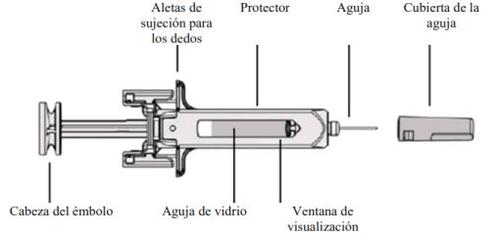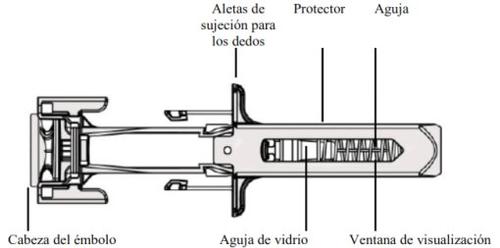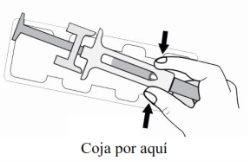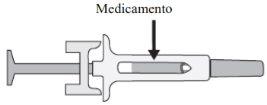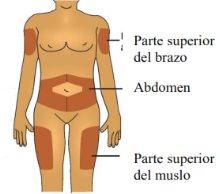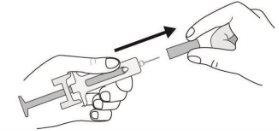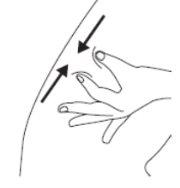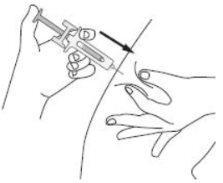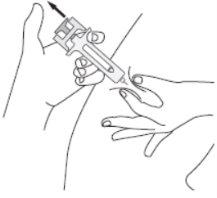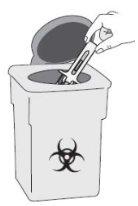
FULPHILA 6 mg SOLUTION FOR INJECTION IN PRE-FILLED SYRINGE

How to use FULPHILA 6 mg SOLUTION FOR INJECTION IN PRE-FILLED SYRINGE
Introduction
Package Leaflet: Information for the User
Fulphila 6 mg Solution for Injection in Pre-filled Syringe
Pegfilgrastim
Read all of this leaflet carefully before you start using this medicine because it contains important information for you.
- Keep this leaflet, you may need to read it again.
- If you have any further questions, ask your doctor, pharmacist, or nurse.
- This medicine has been prescribed for you only. Do not pass it on to others. It may harm them, even if their signs of illness are the same as yours.
- If you get any side effects, talk to your doctor, pharmacist, or nurse. This includes any possible side effects not listed in this leaflet. See section 4.
Contents of the Package Leaflet
- What is Fulphila and what is it used for
- What you need to know before you use Fulphila
- How to use Fulphila
- Possible side effects
- Storage of Fulphila
- Contents of the pack and other information
1. What is Fulphila and what is it used for
Fulphila contains the active substance pegfilgrastim. Pegfilgrastim is a protein produced by biotechnology in the bacteria E. coli. Pegfilgrastim belongs to a group of proteins called cytokines and is very similar to a natural protein (granulocyte-colony stimulating factor) that our body produces.
Fulphila is used to reduce the duration of neutropenia (low white blood cell count) and the incidence of febrile neutropenia (low white blood cell count and fever) that can occur as a result of cytotoxic chemotherapy (medicines that destroy rapidly dividing cells). White blood cells are important cells that help fight infections. These cells are sensitive to the effects of chemotherapy, which can cause their numbers to decrease. If the number of white blood cells becomes too low, there may not be enough to fight off bacteria, which can lead to a higher risk of infection.
Your doctor has prescribed Fulphila to stimulate your bone marrow (the part of the bone where blood cells are produced) to produce more white blood cells to help fight infections.
Fulphila is indicated in patients over 18 years of age.
2. What you need to know before you use Fulphila
Do not use Fulphila
- if you are allergic to pegfilgrastim, filgrastim, or any of the other ingredients of this medicine (listed in section 6).
Warnings and precautions
Talk to your doctor, pharmacist, or nurse before starting Fulphila:
- if you experience an allergic reaction that includes weakness, low blood pressure, difficulty breathing, swelling of the face (anaphylaxis), redness, and itching of the skin.
- if you experience cough, fever, and difficulty breathing. This may be a sign of Acute Respiratory Distress Syndrome (ARDS).
- if you experience any or a combination of the following side effects:
- swelling that may be associated with decreased urine output, difficulty breathing, swelling, and a feeling of fullness in the abdomen, and a general feeling of tiredness.
These may be symptoms of a condition called "capillary leak syndrome" and can cause blood to leak from small blood vessels into other parts of your body. See section 4.
- if you have pain in the upper left abdomen or pain in the tip of the shoulder. This may be a sign of a problem with the spleen (splenomegaly).
- if you have recently had a severe lung infection (pneumonia), fluid in the lungs (pulmonary edema), inflammation of the lungs (interstitial lung disease), or an abnormal chest X-ray (pulmonary infiltrate).
- if you are aware of any changes in your blood cell count (e.g., increased white blood cell count or anemia) or a decrease in your platelet count, which can reduce the ability of your blood to clot (thrombocytopenia). Your doctor may want to monitor you more closely.
- if you have sickle cell anemia. Your doctor may monitor your condition more closely.
- if you are a cancer patient, the combined treatment of Fulphila with chemotherapy and/or radiotherapy may increase the risk of developing a pre-cancerous hematological disorder called myelodysplastic syndrome (MDS) or a hematological malignancy called acute myeloid leukemia (AML). Symptoms may include fatigue, fever, easy bruising or bleeding.
- if you have sudden signs of allergy, such as rash, itching, or hives on the skin, swelling of the face, lips, tongue, or other parts of the body, shortness of breath, wheezing, or difficulty breathing; these may be signs of a severe allergic reaction.
- if you have symptoms of inflammation of the aorta (the large blood vessel that carries blood from the heart to the rest of the body), this has rarely been reported in cancer patients and healthy donors. Symptoms may include fever, abdominal pain, general malaise, back pain, and increased inflammatory markers. Inform your doctor if you experience these symptoms.
Your doctor will regularly perform blood and urine tests, as Fulphila may damage the small filters within the kidneys (glomerulonephritis).
With the use of pegfilgrastim, serious skin reactions (Stevens-Johnson syndrome) have been reported. Stop using Fulphila and seek medical attention immediately if you observe any of the symptoms described in section 4.
You should discuss with your doctor the risk of developing blood cancer. If you present or may present blood cancer, you should not use Fulphila, unless your doctor advises you to.
Loss of response to Fulphila
If you experience a loss of response or if it is not possible to maintain the response to treatment with pegfilgrastim, your doctor will investigate the causes, including whether you have developed antibodies that may neutralize the activity of pegfilgrastim.
Children and adolescents
The use of Fulphila is not recommended in children and adolescents, as there is not enough data available on its safety and efficacy.
Other medicines and Fulphila
Tell your doctor or pharmacist if you are using, have recently used, or might use any other medicines.
Pregnancy and breastfeeding
If you are pregnant or breastfeeding, think you may be pregnant, or plan to become pregnant, consult your doctor or pharmacist before using this medicine.
Fulphila has not been used in pregnant women. Therefore, your doctor may decide that you should not use this medicine.
If you become pregnant during treatment with Fulphila, inform your doctor.
Unless your doctor tells you otherwise, you must stop breastfeeding if you use Fulphila.
Driving and using machines
Fulphila has no or negligible influence on the ability to drive and use machines.
Fulphila contains sorbitol and sodium
This medicine contains 30 mg of sorbitol in each pre-filled syringe, which is equivalent to 50 mg/ml.
This medicine contains less than 1 mmol of sodium (23 mg) per 6 mg dose, which is essentially "sodium-free".
3. How to use Fulphila
Follow exactly the instructions for administration of this medicine given by your doctor. If you are unsure, consult your doctor or pharmacist again.
The recommended dose is a single subcutaneous injection of 6 mg (under the skin) with a pre-filled syringe, and should be administered at the end of each chemotherapy cycle, at least 24 hours after the last dose of chemotherapy.
Self-injection of Fulphila
Your doctor may consider it more convenient for you to inject Fulphila yourself. Your doctor or nurse will teach you how to do it. Do not attempt to do it if you have not been taught.
For further instructions on how to inject Fulphila yourself, read the attached instructions. Do not shake Fulphila vigorously, as this may affect its activity.
If you use more Fulphila than you should
If you use more Fulphila than you should, contact your doctor, pharmacist, or nurse.
If you forget to use Fulphila
If you have forgotten to administer your dose of Fulphila, contact your doctor to decide when you should inject the next dose.
If you have any other questions on the use of this medicine, ask your doctor, pharmacist, or nurse.
4. Possible side effects
Like all medicines, this medicine can cause side effects, although not everybody gets them.
Tell your doctor immediately if you experience any or a combination of the following side effects:
- swelling that may be associated with decreased urine output, difficulty breathing, swelling, and a feeling of fullness in the abdomen, and a general feeling of tiredness. These symptoms usually develop very quickly.
These may be symptoms of a condition called "capillary leak syndrome" that can cause blood to leak from small blood vessels into other parts of your body and requires urgent medical attention.
Very common side effects(may affect more than 1 in 10 people)
- bone pain. Your doctor will inform you about what you can take to relieve the pain.
- nausea and headaches.
Common side effects(may affect up to 1 in 10 people)
- pain at the injection site.
- general pain and pain in the joints and muscles.
- some changes in your blood may occur, which will be detected by regular blood tests. The number of white blood cells may increase for a short period. The number of platelets may decrease, which can cause bruising.
- chest pain.
Uncommon side effects(may affect up to 1 in 100 people)
- allergic reactions, including redness, flushing, rash, and itching of the skin.
- severe allergic reactions, including anaphylaxis (weakness, low blood pressure, difficulty breathing, facial swelling).
- sickle cell crisis in patients with sickle cell anemia.
- enlargement of the spleen.
- splenic rupture. Some cases of splenic rupture were fatal. It is important that you contact your doctor immediately if you notice pain in the upper left abdomen or left shoulder tip, as this could be related to a problem with the spleen.
- respiratory problems. If you have a cough, fever, and difficulty breathing, consult your doctor.
- cases of Sweet's syndrome (painful, inflamed, purple-colored lesions on the limbs and sometimes on the face and neck, accompanied by fever) have been reported, but may be related to other factors.
- cutaneous vasculitis (inflammation of the blood vessels in the skin).
- damage to the small filters within the kidneys (glomerulonephritis).
- redness at the injection site.
- bleeding from the lungs (hemoptysis).
- hematological disorders (MDS or AML).
Rare side effects(may affect up to 1 in 1,000 people)
- inflammation of the aorta (the large blood vessel that carries blood from the heart to the rest of the body), see section 2.
- bleeding from the lungs (pulmonary hemorrhage).
- Stevens-Johnson syndrome, which can appear as red, circular, or concentric patches, often with central blisters on the trunk, exfoliation, ulcers in the mouth, throat, nose, genitals, and eyes; and may be preceded by fever and flu-like symptoms. Stop using Fulphila and seek medical attention immediately if you develop these symptoms. See section 2.
Reporting of side effects
If you experience any side effects, talk to your doctor, pharmacist, or nurse. This includes any possible side effects not listed in this leaflet. You can also report side effects directly via the national reporting system listed in Appendix V. By reporting side effects, you can help provide more information on the safety of this medicine.
5. Storage of Fulphila
Keep this medicine out of the sight and reach of children.
Do not use this medicine after the expiry date which is stated on the carton, blister, and label of the pre-filled syringe after EXP. The expiry date is the last day of the month stated.
Store in a refrigerator (2°C to 8°C).
Do not freeze. Fulphila may be used if it has been accidentally frozen for a period of less than 24 hours.
Keep the container in the outer carton to protect it from light.
Fulphila may be stored at room temperature (below 30°C) for a maximum of 3 days. Once a pre-filled syringe has been removed from the refrigerator and reaches room temperature (below 30°C), it must be used within 3 days or discarded.
Do not use this medicine if you notice that the solution is not entirely clear or contains particles.
Medicines should not be disposed of via wastewater or household waste. Ask your pharmacist how to dispose of medicines no longer required. This will help protect the environment.
6. Package Contents and Additional Information
Fulphila Composition
- The active ingredient is pegfilgrastim. Each prefilled syringe contains 6 mg of pegfilgrastim in 0.6 ml of solution.
- The other components are sodium acetate, sorbitol (E420), polysorbate 20, and water for injectable preparations. See section 2 "Fulphila contains sorbitol and sodium acetate".
Product Appearance and Package Contents
Fulphila is a clear and colorless injectable solution (injection) contained in a glass prefilled syringe with a stainless steel needle and a needle cap. The syringe is provided in a blister pack.
Each package contains 1 prefilled syringe.
Marketing Authorization Holder
Biosimilar Collaborations Ireland Limited
Unit 35/36
Grange Parade,
Baldoyle Industrial Estate,
Dublin 13
DUBLIN
Ireland
D13 R202
Manufacturer
Biosimilar Collaborations Ireland Limited
Block B, The Crescent Building, Santry Demesne
Dublin
D09 C6X8
Ireland
You can request more information about this medication by contacting the local representative of the marketing authorization holder.
België/Belgique/Belgien Biocon Biologics Belgium BV Tél/Tel: 0080008250910 | Lietuva Biosimilar Collaborations Ireland Limited Tel: 0080008250910 |
| Luxembourg/Luxemburg Biocon Biologics France S.A.S Tél/Tel: 0080008250910 |
Ceská republika Biocon Biologics Germany GmbH Tel: 0080008250910 | Magyarország Biosimilar Collaborations Ireland Limited Tel: 0080008250910 |
Danmark Biocon Biologics Finland OY Tlf: 0080008250910 | Malta Biosimilar Collaborations Ireland Limited Tel: 0080008250910 |
Deutschland Biocon Biologics Germany GmbH Tel: 0080008250910 | Nederland Biocon Biologics France S.A.S. Tel: 0080008250910 |
Eesti Biosimilar Collaborations Ireland Limited Tel: 0080008250910 | Norge Biocon Biologics Finland OY Tlf: +47 800 62 671 |
Ελλ?δα Biocon Biologics GreeceΜΟΝΟΠΡΟΣΩΠΗΙ.Κ.Ε Τηλ: 0080008250910 | Österreich Biocon Biologics Germany GmbH Tel: 0080008250910 |
España Biocon Biologics Spain S.L. Tel: 0080008250910 | Polska Biosimilar Collaborations Ireland Limited Tel:.: 0080008250910 |
France Biocon Biologics France S.A.S Tél: +Teél: 0080008250910 | Portugal Biocon Biologics Spain S.L.. Tel: 0080008250910 |
Hrvatska Biocon Biologics Germany GmbH Tel: 0080008250910 | România Biosimilar Collaborations Ireland Limited Tel: 0080008250910 |
Ireland Biosimilar Collaborations Ireland Limited Tel: 1800 777 794 | Slovenija Biosimilar Collaborations Ireland Limited Tel: 0080008250910 |
Ísland Biocon Biologics Finland OY Sími:+345 8004316 | Slovenská republika Biocon Biologics Germany GmbH Tel: 0080008250910 |
Italia Biocon Biologics Spain S.L. Tel: 0080008250910 | Suomi/Finland Biocon Biologics Finland OY Puh/Tel: 99980008250910 |
Κ?προς Biosimilar Collaborations Ireland Limited Τηλ: 0080008250910 | Sverige Biocon Biologics Finland OY Tel: 0080008250910 |
Latvija Biosimilar Collaborations Ireland Limited Tel: 0080008250910 |
Date of the last revision of this prospectus: {MM/AAAA}.
Other sources of information
Detailed information about this medication is available on the European Medicines Agency website: http://www.ema.europa.eu.
---------------------------------------------------------------------------------------------------------------------
Instructions for use: |
Component guide |
Before use |
|
After use |
|
Important | ||
|
Step 1: Preparation | |
A. | Remove the tray containing the prefilled syringe from the package and gather the materials needed for the injection: alcohol swabs, cotton balls or gauze, band-aids, and a sharps container (not included). |
To make the injection less painful, leave the prefilled syringe at room temperature for about 30 minutes before the injection. Wash your hands well with soap and water. Place the new prefilled syringe and other materials on a clean and well-lit surface.
|
B. | Open the package by removing the cover. Hold the prefilled syringe by the safety protector to remove it from the tray. |
For safety reasons:
|
C. | Examine the medication and the prefilled syringe. |
In any of these cases, contact your doctor or healthcare professional. |
Step 2: Prepare | |
A. | Wash your hands well. Prepare and clean the injection site. |
You can inject the medication into:
Clean the injection site with an alcohol swab. Let the skin dry.
Do not inject into areas where the skin is sensitive, bruised, red, or hardened. Avoid injecting into areas with scars or stretch marks. |
B | Carefully pull the gray needle cap straight off, keeping the syringe away from your body. |
|
C | Pinch the injection site to create a firm surface. |
It is essential to keep the skin pinched when injecting. |
Step 3: Inject | |
A | Keep the skin pinched. INSERT the needle into the skin. |
|
B | PRESS the plunger head with light and constant pressure until you feel or hear a "click". Press all the way down until you hear the "click". |
It is essential to press all the way down until you hear the "click" to receive your full dose. |
C | RELEASE the plunger head. Then, REMOVE the syringe from the skin. |
After releasing the plunger head, the prefilled syringe's safety protector will safely cover the needle.
|
For healthcare professionals only The trade name of the administered product must be correctly recorded in the patient's medical history. |
Step 4: Final | |
A | Discard the used prefilled syringe and other materials in a sharps container. |
Medications should be disposed of in accordance with local regulations. Ask your pharmacist how to dispose of packaging and medications that are no longer needed. This will help protect the environment. Keep the syringe and sharps container out of the sight and reach of children.
|
B | Examine the injection site. |
If you see blood, press a cotton ball or gauze over the injection site. Do not rub the injection site. Apply a band-aid if necessary. |
- Country of registration
- Active substance
- Prescription requiredYes
- Manufacturer
- This information is for reference only and does not constitute medical advice. Always consult a licensed doctor before taking any medication. Oladoctor is not responsible for medical decisions based on this content.
- Alternatives to FULPHILA 6 mg SOLUTION FOR INJECTION IN PRE-FILLED SYRINGEDosage form: INJECTABLE, 6 mg of pegfilgrastim (10mg/ml)Active substance: pegfilgrastimManufacturer: Amgen Europe B.V.Prescription requiredDosage form: INJECTABLE, 6 mgActive substance: pegfilgrastimManufacturer: Amgen Europe B.V.Prescription requiredDosage form: INJECTABLE, 6 mgActive substance: pegfilgrastimManufacturer: Pfizer Europe Ma EeigPrescription required
Alternatives to FULPHILA 6 mg SOLUTION FOR INJECTION IN PRE-FILLED SYRINGE in other countries
The best alternatives with the same active ingredient and therapeutic effect.
Alternative to FULPHILA 6 mg SOLUTION FOR INJECTION IN PRE-FILLED SYRINGE in Ukraine
Online doctors for FULPHILA 6 mg SOLUTION FOR INJECTION IN PRE-FILLED SYRINGE
Discuss dosage, side effects, interactions, contraindications, and prescription renewal for FULPHILA 6 mg SOLUTION FOR INJECTION IN PRE-FILLED SYRINGE – subject to medical assessment and local rules.




